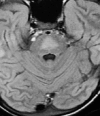Alopecia Areata and Demyelination as Paraneoplastic Manifestation in Paediatric Hodgkin's Lymphoma
- PMID: 30233770
- PMCID: PMC6141432
Alopecia Areata and Demyelination as Paraneoplastic Manifestation in Paediatric Hodgkin's Lymphoma
Abstract
Hodgkin's Lymphoma is one of the commonly encountered lymphomas in childhood. Most of the children present with lymphadenopathy. A rare subset of children do present with constellation of atypical symptoms as paraneoplastic syndromes. We hereby present an 11-year-old boy with classical Hodgkin's Lymphoma associated with Alopecia areata and demyelination as paraneoplastic manifestations. Both these paraneoplastic manifestations improved after initiating chemotherapy (ABVD regimen). A high index of suspicion for underlying malignancy would help clinicians in clinching an early diagnosis and would avert the associated complications.
Keywords: Alopecia areata; Hodgkin's lymphoma; Paraneoplastic syndrome; Pontine myelinolysis.
Figures




Similar articles
-
Alopecia areata as a paraneoplastic syndrome of Hodgkin's lymphoma: A case report.Mol Clin Oncol. 2014 Jul;2(4):596-598. doi: 10.3892/mco.2014.274. Epub 2014 Apr 9. Mol Clin Oncol. 2014. PMID: 24940502 Free PMC article.
-
Hodgkin's Lymphoma Presenting as Alopecia.Int J Trichology. 2012 Jul;4(3):169-71. doi: 10.4103/0974-7753.100085. Int J Trichology. 2012. PMID: 23180928 Free PMC article.
-
Mucocutaneous Paraneoplastic Syndrome Secondary to Classical Hodgkin's Lymphoma.Clin Pract Cases Emerg Med. 2019 Apr 2;3(2):160-161. doi: 10.5811/cpcem.2019.3.41759. eCollection 2019 May. Clin Pract Cases Emerg Med. 2019. PMID: 31061977 Free PMC article.
-
[Acute sensory neuropathy associated with Hodgkin's lymphoma: a case study].Rinsho Shinkeigaku. 2019 Jun 22;59(6):349-355. doi: 10.5692/clinicalneurol.cn-001271. Epub 2019 May 29. Rinsho Shinkeigaku. 2019. PMID: 31142709 Review. Japanese.
-
Clinical manifestations and natural history of Hodgkin's lymphoma.Cancer J. 2009 Mar-Apr;15(2):124-8. doi: 10.1097/PPO.0b013e3181a282d8. Cancer J. 2009. PMID: 19390307 Review.
Cited by
-
Review of Paraneoplastic Syndromes in Children with Malignancy.Med Sci Monit. 2025 Mar 31;31:e947393. doi: 10.12659/MSM.947393. Med Sci Monit. 2025. PMID: 40159669 Free PMC article. Review.
References
-
- Rico JF, Tebbi CK. Hodgkin Lymphoma in Children : A Review. Austin J Pediatr. 2014;1(3):1–7.
Publication types
LinkOut - more resources
Full Text Sources
